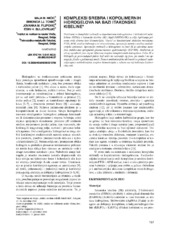Приказ основних података о документу
Silver(I)-Complexes with An Itaconic Acid-Based Hydrogel
| dc.creator | Mićić, Maja M. | |
| dc.creator | Tomić, Simonida Lj. | |
| dc.creator | Filipović, Jovanka M. | |
| dc.creator | Suljovrujić, Edin H. | |
| dc.date.accessioned | 2018-03-03T14:39:41Z | |
| dc.date.available | 2018-03-03T14:39:41Z | |
| dc.date.issued | 2009 | |
| dc.identifier.issn | 0367-598X | |
| dc.identifier.uri | https://vinar.vin.bg.ac.rs/handle/123456789/6851 | |
| dc.description.abstract | Silver(I) itaconic acid-based hydrogel complexes were synthesized and characterized in order to examine the potential use of these systems; FTIR, AFM, in vitro fluid-uptake, metal sorption and antibacterial activity assay measurements were used for the characterization. Metal (silver(I)) ion uptaken by IA-based hydrogels was determined by inductively coupled plasma mass spectrometry. The coordination sites for metal ions were identified and the stability in in vitro condition was determined. Incorporation of silver(l) ions into hydrogels and the influence of these ions on the diffusion properties of hydrogels were analyzed and discussed, too; it was found that the itaconic acid moiety in hydrogels is the determining factor which influences metal ion binding and therefore fluid uptake inside the polymeric network. Furthermore, Silver(I) itaconic acid-based hydrogel showed a satisfactory antibacterial activity. The most advanced feature of these materials is that the silver ions embedded throughout the networks leaches out via controlled manner with time in aqueous media. Therefore, the ions escape from the swollen networks with time and interact with the bacteria. Because of a good dispersion of silver ions in Ag(I)-P(HEMA/2IA) hydrogel complex, we have evaluated the antibacterial activity for this sample. As expected, the number of colonies grown surrounding the Ag(I)-P(HEMA/2IA) hydrogel complex was found to be almost nil, whereas the pare P(HEMA/2IA) hydrogel did not show any effect on Escherichia coli. Therefore, we conclude that the Ag(I)-P(HEMA/IA) hydrogel complexes are excellent antibacterial materials. Due to these facts, the silver ion IA-based hydrogel complexes reported here might be used as smart materials in the range of biomedical applications, including drug-delivery devices, biosensors, wound healing dressings, tissue reconstruction and organ repair. | en |
| dc.rights | openAccess | en |
| dc.source | Hemijska industrija | en |
| dc.subject | 2-Hydroxyethyl methacrylate | en |
| dc.subject | Itaconic acid | en |
| dc.subject | Hydrogel | en |
| dc.subject | Silver(I) ion | en |
| dc.subject | Antibacterial activity | en |
| dc.title | Silver(I)-Complexes with An Itaconic Acid-Based Hydrogel | en |
| dc.type | article | en |
| dcterms.abstract | Мициц, Маја М.; Филиповиц, Јованка М.; Шуљоврујић Един Х.; Томиц, Симонида Љ.; | |
| dc.citation.volume | 63 | |
| dc.citation.issue | 3 | |
| dc.citation.spage | 137 | |
| dc.citation.epage | 142 | |
| dc.identifier.wos | 000272436600001 | |
| dc.identifier.doi | 10.2298/HEMIND0903137M | |
| dc.citation.rank | M23 | |
| dc.description.other | 7th Seminar of Young Researchers, Dec 22-24, 2008, Belgrade, Serbia | en |
| dc.identifier.scopus | 2-s2.0-77952917724 | |
| dc.identifier.fulltext | https://vinar.vin.bg.ac.rs//bitstream/id/13791/6847.pdf |

